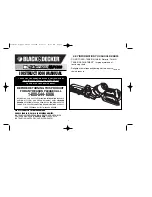
5
GB
SAFETY INSTRUCTION FOR CUT OFF SAW
Symbols
Observe the dimensions of the saw blade. The hole diameter must match the tool
spindle without play.
Danger Area! Keep hands far away from the cutting area while the machine is running.
Keep bystanders away.
• Keep the lower wheel guard attached and working properly and the guard in the maximum wheel
covering position over the workpiece in operation. Keep your body positioned to either side of the wheel,
but not in line with the wheel. It is important to position your body and the guard to minimize body
exposure from the possible fragments of a burst wheel.
• Abrasive Cut Off Wheels must have a maximum safe operating speed greater than the “no load RPM”
marked on the tool’s nameplate. Wheels running over the rated speed can fly apart and cause injury.
• Keep hands away from cutting area and wheel. NEVER place your hand behind the wheel. Do not attempt
to remove cut material when wheel is moving. Contact with the spinning wheel may cause serious personal
injury.
• Wear proper apparel while using an abrasive cut off machine. Face shield or at least safety goggles, dust
mask, leather gloves and shop apron capable of stopping small wheel or workpiece fragments.
• Use only Type 1 abrasive cut off wheels with the correct size arbor hole. Never use damaged or incorrect
wheel flanges or round nut. Other types of wheels are not intended to apply load on periphery and may
shatter. Wheels with arbor holes that do not match the mounting hardware of the tool will run eccentrically,
vibrate excessively and will cause loss of control.
• Do not use a cut off wheel that is larger than the maximum recommended size for your tool, or worn
down damaged wheels from larger abrasive cut off machines. Wheels intended for larger tools are not
suitable for the higher speed of a smaller tool, these wheels may easily burst and the fragments strike you
or bystanders.
• Before each use inspect the cut off wheel for chips and cracks. Do not use a wheel that may be damaged.
Install a new wheel if tool was dropped. When installing a new wheel carefully handle individual cut off
wheels to avoid chipping or cracking. Run the tool at no load for one minute, holding the tool’s cutting head
down and in the direction away from people. Wheels with flaws will normally break apart during this time.
Fragments from a wheel that bursts during operation will fly away at great velocity possibly striking you or
bystanders.
• Do not grind on the side of Type 1 abrasive cut off wheels. Side forces applied to these wheels may cause
them to shatter.
• Always use the vise to clamp the work and properly support the over-hanging portion or the workpiece
level with the base of the machine. Proper support of workpiece is important to keep the cut off and over-
hanging pieces from falling and striking the operator.
• Do not “jam” the abrasive wheel into the work or apply excessive pressure while using this machine.
Avoid bouncing and snagging the wheel, especially when working corners, sharp edges etc. If the wheel is
damaged due to misuse it may develop cracks and eventually burst or shatter without warning.
• Keep the depth stop properly adjusted. If the depth stop is improperly set it may cause the tool to flip
over when releasing the cutting head too quickly or if the depth is set too deep the wheel may cut into the
surface below the base.
• This machine is not intended to be used with Wet Diamond Wheels. Using water or other liquid coolants
with this machine may result in electrocution or shock. Use of Dry Diamond Wheels is acceptable.
• Do not use this tool with “Woodcarving” blade or standard wood cutting toothed blades. These blades
Summary of Contents for MPBCO355
Page 2: ...1 5 2 6 8 9 16 10 12 14 15 16 7 4 3 11 13 ...
Page 3: ...9 9a 9b 9c Figure 3 9 9c Figure 5 ...
Page 4: ......
Page 68: ...64 FA EC 19 2012 ...
Page 69: ...65 FA ...
Page 70: ...66 FA ...
Page 71: ...67 FA ...
Page 72: ...68 FA ...
Page 73: ...69 FA ...
Page 74: ...70 FA ...
Page 75: ...71 FA ...
Page 76: ...72 FA 72 71 71 71 71 69 68 66 64 EN 60129 ...
Page 77: ...73 AR EC 19 2012 ...
Page 78: ...74 AR ...
Page 79: ...75 AR ...
Page 80: ...76 AR ...
Page 81: ...77 AR ...
Page 82: ...78 AR ...
Page 83: ...79 AR ...
Page 84: ...80 AR ...
Page 85: ...81 AR ...










































